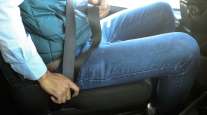Out-of-Service Rates 2nd-Lowest on Record at Roadcheck 2012 Event, CVSA Reports
This story appears in the Aug. 20 print edition of Transport Topics.
Out-of-service rates both for drivers and for vehicles inspected during this year’s Roadcheck were the second lowest in the 25-year history of the safety event, the Commercial Vehicle Safety Alliance said last week.
Overall, 95.4% of all truck and bus drivers passed inspections during the annual three-day stretch of stepped up commercial vehicle inspections through North America, which took place June 5-7. Only 4.6% were placed out of service, CVSA said, trailing last year’s record low 4.2% out-of-service rate.
Likewise, the overall out-of-service rate for all vehicle inspections was 20.9%, compared with the record low of 19.3% set in 2011.
CVSA also said the out-of-service rate for Level 1 inspections, the most comprehensive, declined to 22.4%, from 22.8% last year.
“Out-of-service rate did uptick a little bit,” Stephen Keppler, CVSA’s executive director, told Transport Topics. “But historically, when you look at the program over its 25-year history, they’re still fairly low.”
Out-of-service violations can range from brakes requiring adjustments to improperly inflated tires and broken suspensions, Keppler said.
David Osiecki, senior vice president of policy and regulatory affairs for American Trucking Associations, called the latest numbers encouraging.
“Both the enforcement community and the trucking industry should share in the credit for the continued positive trend in violation reduction and, more importantly, the historically low crash rates,” Osiecki said.
Law enforcement inspectors conducted a record 74,072 truck and bus inspections during Roadcheck, Keppler said. Of that total, 48,815 were Level 1 inspections.
“Despite the positive trend in the Level 1’s, this highlights that one in five vehicles selected for inspection was found with a violation serious enough to be considered an imminent safety hazard,” CVSA said in a statement. “These mixed results indicate that, while the attention paid by industry to maintenance and regulatory compliance is improving, more needs to be done by industry and enforcement alike.”
CVSA’s Roadcheck report said that 84.4% of the vehicles passed hazmat inspections, and 15.6% were placed out of service. During the 2011 Roadcheck, 17.9% of hazmat vehicles were placed out of service.
Keppler said he was pleased that the percentage of hours-of-service, brake adjustment and brake system violations had decreased — areas of emphasis in this year’s Roadcheck. “That shows that people did pay attention and did their best to try and stay in compliance,” he said.
But Keppler said the slight increase in the rate that vehicles and drivers were placed out of service bears close attention. “The economy is turning around in the trucking industry, and there are capacity issues,” he said. “People need to move loads. Sometimes when that’s the case, people don’t pay as much attention to regulatory compliance and maintenance.”
Keppler said he also was concerned with an increase in the rate of logbook violations as a percentage of all out-of-service violations. “Fifteen percent of the drivers’ out-of-service violations were for false logs,” Keppler said. “That’s the highest it’s ever been.”
ATA’s Osiecki cautioned that the Roadcheck numbers are not statistically valid.“I don’t believe CVSA runs statistical significance tests on their Roadcheck data because the data are not collected in a random manner,” he said. “In other words, they target trucks for inspections based on information they have about the carrier’s past compliance record.”
Osiecki said the trucking industry should work closely with CVSA to encourage a shift away from Level 1 inspections and toward driver-focused inspections resulting from more traffic-enforcement activity.
“The condition of the truck does not cause many crashes,” he said. “Drivers, both noncommercial and commercial, cause most of the crashes.” For that reason, inspections should focus on improving driver behavior and compliance with traffic laws, Osiecki said.
But Keppler said Level 1 inspections include drivers and are necessary: “While I would agree that drivers are principally part of the crash picture, in an evasive maneuver or in a crash type scenario, your vehicle needs to be operating optimally to be able to perform,” he said.
“The driver could be the best driver in the world, but if his braking system isn’t operating at an optimum level it doesn’t matter,” Keppler said.




